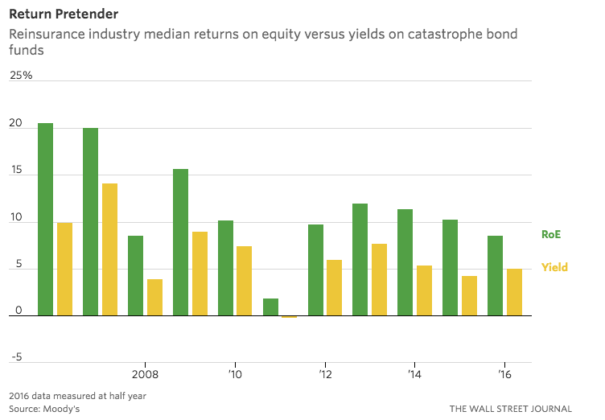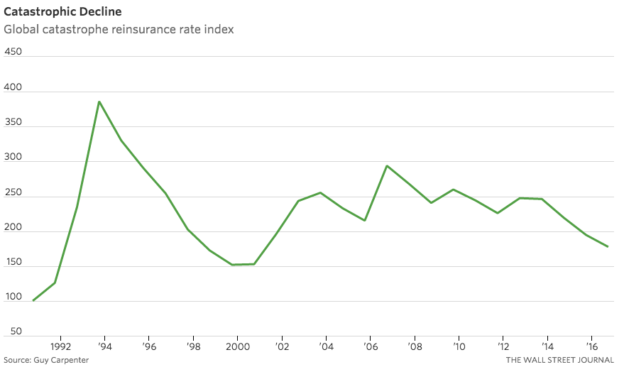This is interesting. AIG has been very active this year in using reinsurance. Simply put, an insurer can lay off some of its risk to a third party by purchasing reinsurance. It does a couple things: First, it limits the risk the insurer is exposed to as it caps it. For example, the insurer may be on the hook for the first $400M in damages from an event and then the reinsurer picks up anything over. Second, it allows them to hold fewer reserves because their risk for that insurance is defined. This in part is helping fuel AIG’s buybacks (the cash release from reserves).
What the article below tells us is that AIG is purchasing this reinsurance at a time when rates are historically very low (been a while since a “super cat” event). That means AIG is getting a great return on these dollars. They are paying very low prices for the reinsurance that allows them to release reserves and buy back stock well below BV. IMO a GREAT use of cash all around.
WSJ:
The insurance industry is in a tight spot. This is most obvious in property reinsurance, but that is one symptom of a squeeze across the sector.
Global catastrophe reinsurance prices fell this year below levels last seen in 2001 before the destruction of the World Trade Center, according to Guy Carpenter, a research firm owned by brokers Marsh & McLennan.
The question for property and casualty insurers isn’t only whether reinsurance pricing will find a floor, but also how much the industry is now starting to amplify financial and actuarial risks.
Ultralow investment returns are hurting profits while drawing a wider range of yield-hungry investors into becoming suppliers of alternative capital to underwrite reinsurance risks. At the same time, the lack of costly disasters in recent years has helped a surfeit of capital build up, making it cheap.The drop in prices is slowing, according to Moody’s, but they are still declining. Similarly, the growth of alternative capital in the form of catastrophe bonds and other vehicles is slowing—but it isn’t going away.
And while some see these trends as early indicators that reinsurance prices may find a floor, there is another problem: demand for reinsurance from ordinary insurers has continued to slow, too.
That’s because ordinary property insurance is suffering low demand itself. Insurance demand is linked to economic activity, which globally has been sluggish. When people and companies drive less, buy less and relocate less, they need less insurance, too.
But as well as slower cyclical growth in many markets, ordinary insurers are also facing longer-term changes that might permanently cut the amount of insurance people and firms need, such as better risk management or use of big data.
Insurers options to improve returns to shareholders then are few. One is to take on more insurance risk. Another is to increase balance-sheet leverage. There are signs that the industry is doing both.

Reinsurers are writing policies with higher probable maximum losses, according to Moody’s—especially those linked to U.S. hurricanes. U.S. storms are the biggest area of the catastrophe market because there is more insured property in the line of fire than for any other regularly expected event.The largest loss reinsurers expect from a one-in-250-year sized U.S. hurricane event is equivalent to 16% of their equity this year on average, up almost 2 percentage points from last year, leaving reinsurers more exposed to natural catastrophe despite lower pricing, Moody’s said.
There are also fears that ordinary insurers will become more aggressive with reserving policies, putting aside less money to cover expected claims, to boost underwriting profits, according to CreditSights, a research firm. That will hurt tomorrow’s profits if they underestimate today’s claims.
Finally, reinsurers hunting for new business are trying to sell more structured policies designed to release capital from ordinary insurers’ balance sheets, which can fund shareholder payouts or investments elsewhere. That risks concentrating the industry’s capital safety net in fewer hands and adding leverage to the system as a whole.
Left unchecked, increasing leverage and higher risk could see the industry itself heading for catastrophe.
